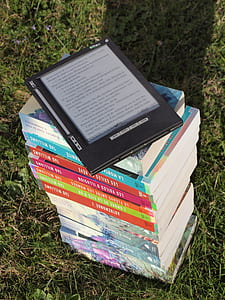Using Fiction to Teach on the Climate Crisis
Reading and discussing fiction gave my students time and space to respond creatively to the climate crisis—and consider how to use their own power to address it.
Reading and discussing fiction gave my students time and space to respond creatively to the climate crisis—and consider how to use their own power to address it.
In a 10th grade English class last year, I taught a unit on climate fiction. I found that examining the climate crisis through the lens of fiction gave my students the time and space to respond more openly, emotionally, and creatively to this issue – not just analytically or according to their preexisting views.

We started with deciphering the complex theme in Margaret Atwood’s “Time Capsule Found on the Dead Planet,” which we paired with the instant class favorite, Kathy Jetnil-Kijiner’s poem “Dear Matafele Peinem.”
For a longer text, I gave students a choice between what I pitched as a silly, sarcastic, and shorter story, “The Day it All Ended” by Charlie Jane Anders, and a disturbing and depressing story, “The Precedent” by Sean McMullen. Anders’ story was more challenging to read with its vocabulary and humor, but reading collaboratively helped students figure out the ironies. McMullen’s story appealed to a lot of my horror fans, though at 20 pages, it was too long for some readers to fully process.
I asked students to put all these pieces together into an essay about what power we may have to stop climate change. I also built in some climate change lessons from the Zinn Education Project: the Thingamabob Game and the Climate Mixer.
I was surprised by how cynical many of my students were about the future of our climate, even at the beginning of the unit. Many were already very aware of the ongoing damage we are inflicting and expressed no hope that we'd be able to change it in the future. Why, I asked? Because people these days are too selfish and too busy to care, they told me.
Other students felt quite the opposite: They had already made up their mind that climate change was not real. A few expressed, very honestly, that they believed God would never destroy humans like that. (I asked them if God ever prevented people from suffering or dying due to the actions of others, but I quickly became uncertain of the appropriate boundaries for religious conversation in public school. You may do better than I.)
In any case, the conversation about climate change was certainly not new to my students. Their positions were already well-established within cultural allegiances.
I found that focusing our attention on climate change fiction and poetry allowed us to set those allegiances aside for a moment and just enter the writers' imaginative worlds. When we're debating what a text means or what the author is working to convey with her choice of imagery, we can temporarily set aside hardened disagreements over that message, and return to them later, perhaps with a deeper understanding of that author's perspective.
I also found that poetry and fiction helped students access and express emotions over climate beyond political anger and disdain for "the other side." Students were able to name how in "Dear Matafele Peinem," Kathy Jetnil-Kijiner uses imagery to make us feel protective of her baby's future, or how Charlie Jane Anders uses irony in "The Day It All Ended" to help us see the foolishness of our economic incentives.
Ultimately, I asked students to use the texts we looked at to analyze their own power to stop climate change. Many remained cynical, but even in that cynicism some expressed a powerful need to choose hope anyway. I want to lean into that hope even more in the future, to help both students and me cope with the realities of this unit.
That's why, when I teach the unit again this fall, I plan to add more creative writing opportunities to draw on my students' rhetorical skills and deep social conscience. Teen artists like Xiuhtezcatl Martinez, Solli, and the ClimateSpeaks poets offer a model for how students can claim their own authority to protest and channel their anger and despair.
We will end by writing our own protest poems and imaginative stories about climate change, or other transformative social disasters. Amid the coronavirus, there is certainly no shortage of parallels to the challenges that we can expect from our future under climate change: distrust of science, deepening inequalities, social disintegration, and death.
With all that in mind, it is even more important to give students the time and space to respond creatively to this crisis—and invite them to consider how to use their own power to address it.
If you have stories about using any of these texts to teach about climate change, please share them with me at soutterson@gmail.com.
See Sarah's expanded and updated guide: Climate Fiction for Students and Teachers.